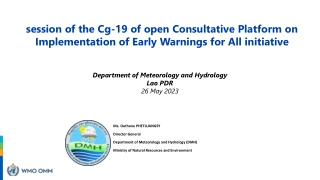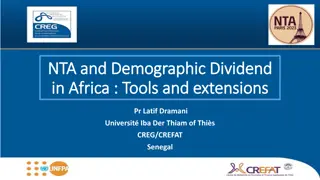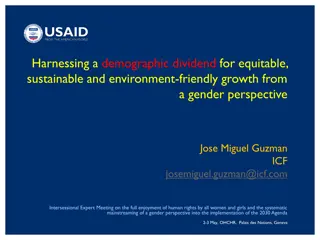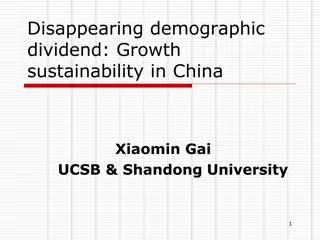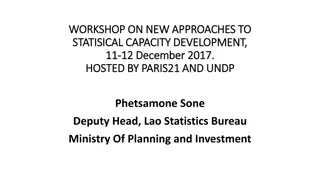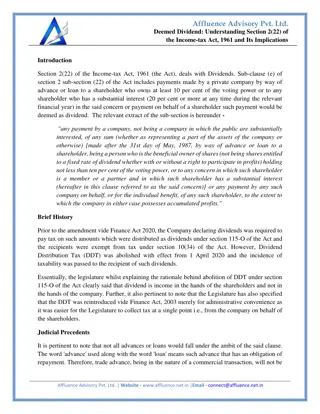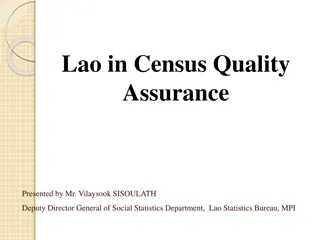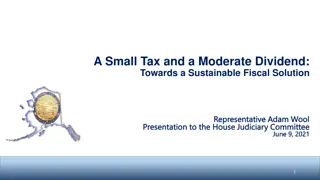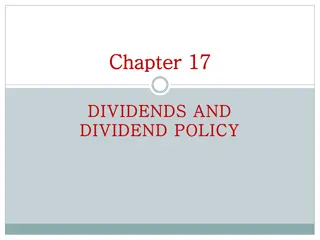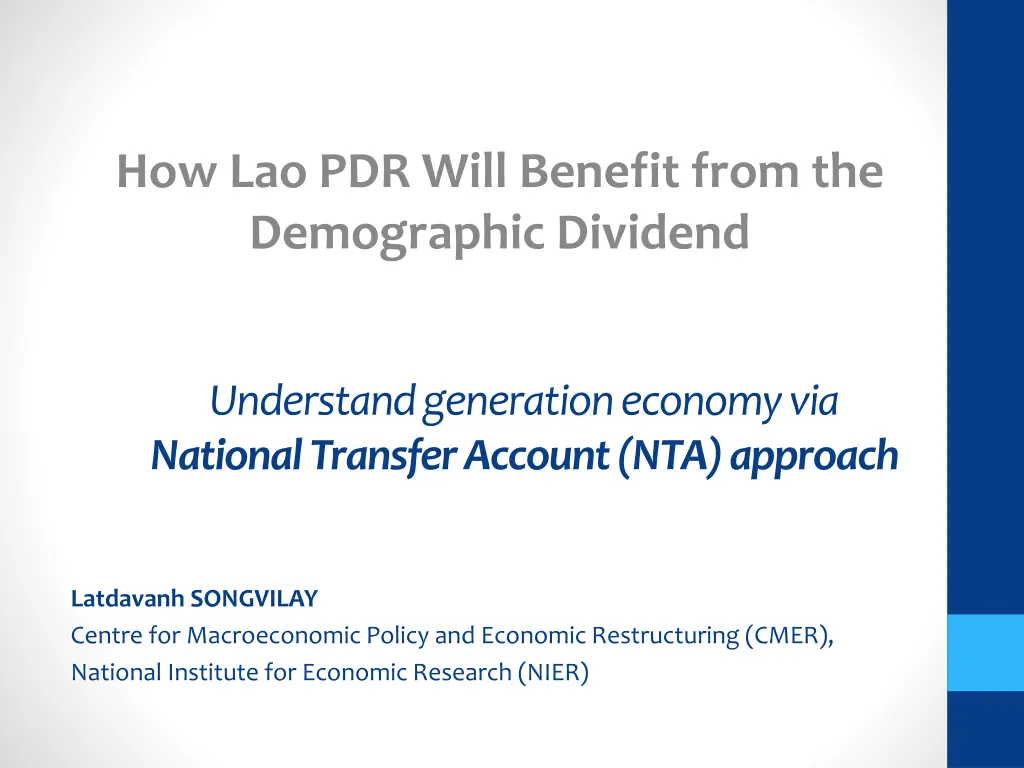
Unlocking Lao PDR's Demographic Dividend Through NTA Approach
Discover how Lao PDR is leveraging the demographic dividend using the National Transfer Account (NTA) approach to analyze the generation economy. This analysis highlights key findings, achievements, and concerns related to NTA in Laos, illustrating the country's progress and future potential.
Download Presentation

Please find below an Image/Link to download the presentation.
The content on the website is provided AS IS for your information and personal use only. It may not be sold, licensed, or shared on other websites without obtaining consent from the author. If you encounter any issues during the download, it is possible that the publisher has removed the file from their server.
You are allowed to download the files provided on this website for personal or commercial use, subject to the condition that they are used lawfully. All files are the property of their respective owners.
The content on the website is provided AS IS for your information and personal use only. It may not be sold, licensed, or shared on other websites without obtaining consent from the author.
E N D
Presentation Transcript
How Lao PDR Will Benefit from the Demographic Dividend Understand generation economy via National Transfer Account (NTA) approach Latdavanh SONGVILAY Centre for Macroeconomic Policy and Economic Restructuring (CMER), National Institute for Economic Research (NIER)
Outline Laos achievement on NTA Key finding on Lao NTA Limitations and future concerns
Laos achievement on NTA Laos first introduced to NTA in 2009 by NUPRI s training on integrate population factors into the national socio-economic plan. In conjunction with National Economic Research Institute (NERI) and Planning Department, Lao Statistic Bureau (LSB) is assigned to take lead in constructing NTA in Laos. Joined NTA trainings in Thailand (2010, 2015) and Malaysia (2016) In-country training by NUPRI (2011) and East-West Centre (2015) The brief report on Lao NTA just printed and will launch soon.
Lao Population structure TFR has declined steadily, from 5.6 births per woman in 1995 to 4.5 in 2005 and 3.2 in 2012 While, proportion of population in working age group increase significantly, pop. growth stays nearly 1.7% in average Source: UN (2014)
Consumption pattern 1,000 Consumption per Capita 160 Thousands Kip Aggregate Consumption Billions Kip 140 800 120 100 600 80 60 400 40 200 20 0 0 10 20 30 40 50 60 70 80 90+ 0 0 10 20 30 40 50 60 70 80 90+ Age Education Health Age Education Health At the individual level, consumption on education is high for children and consumption on health is high for aging people. But at the aggregate level, consumption of pop. under age 15 is higher than those ages 65+ around 28%.
Labour income pattern -Main sources of income are from self-employed labour income -At age 39-40, labour income was highest level 14,000 12,000 10,000 8,000 Thousands kip 6,000 4,000 2,000 0 0 3 6 9 12 15 18 21 24 27 30 33 36 39 42 45 48 51 54 57 60 63 66 69 72 75 78 81 84 87 90 Age Earnings Self-employment
Labour income pattern, per Cap. Compensation of Employees Self-employed income 3,500 12,000 3,000 10,000 2,500 8,000 2,000 6,000 1,500 4,000 Thousands kip 1,000 Thousands kip 2,000 500 0 0 0 10 20 30 40 50 60 70 80 90 0 10 20 30 40 50 60 70 80 90 Male Female Total Male Female Total Pop. start to earn income at early age Male could earn income much higher and last longer than female (gender income gap is noticeable, esp. for the compensation of employees)
The economic lifecycle, per Cap. 14,000 Consumption Labor Income 12,000 10,000 Thousand Kip surplus 8,000 6,000 4,000 deficit 2,000 deficit 0 0 10 20 30 40 50 60 70 80 90+ Age Lao pop. had an income surplus during the age 23-64 While, the rest age group (0-22 and 65+) consume much higher than they earn
The balance between effective producer and effective consumer 25.00 Consumer 11-49 Consumers 10- Consumers 50+ Number of consumers per worker 20.00 15.00 10.00 5.00 0.00 1980 1982 1984 1986 1988 1990 1992 1994 1996 1998 2000 2002 2004 2006 2008 2010 2012 2014 2016 2018 2020 2022 2024 2026 2028 2030 2032 2034 2036 2038 2040 2042 2044 2046 2048 2050 2052 2054 2056 2058 2060 2062 2064 2066 2068 2070 Year The effective number of workers in Laos is relatively small, about 41% of pop., partly because of 1. There are large numbers of dependent children 2. Labour income for young Laotians tends to be low However, there will be an upward trend in such number through the coming decades
Demographic dividend Laos will enjoy a boost to economic growth until about 2052 due to a first demographic dividend 1.50 1.00 Annual rate growth (%) 0.50 0.00 1950 1970 1990 2010 2030 2050 2070 2090 -0.50 -1.00 -1.50 Year
Key highlights for Laos Laos will be able to enjoy higher economic growth from an increasing share of working ages for the (enjoy1st demographic dividend till 2052). However, the first demographic dividend is not automatic. It requires prudent human capital development policy to make it possible. Therefore, need to invest in children s education and health, so that the future labor force will be productive. The share of effective workers to pop. is relative small, partly because labour income of young workers tends to be low, possibly reflecting a low level of skills and capacity. To improve labour income, it is essential to enhance labour productivity through education, training, and capacity building. Many Lao people still involve in seasonal agriculture, thus, many in the labour force are underutilized. Raising labour productivity through a shift in the economic structure toward more productive sectors is crucial.
Limitation and future concerns Data availability, reliability and consistency The awareness of NTA is narrow particularly among policy makers and planner in line ministries. Financial limitation to conduct NTA research and analysis - currently supported by UNFPA and TA from East-West Centre Restructuring of NERI to NIER The cooperation among LSB/MPI and NIER Capacity (human resource) challenges to construct NTA and in-depth research and analysis on NTA including technical capacity, reshuffling of staff, etc

